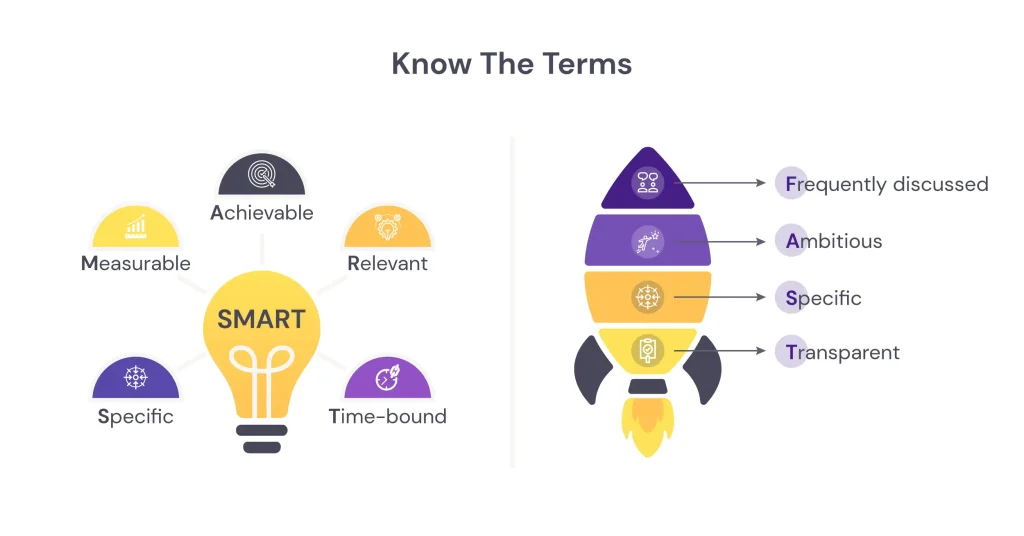Do you follow the SMART and FAST ways to productivity?
Ever wondered what separates thriving companies from stagnant ones? It’s the power of clear, ambitious goals. They are the blueprint for profitability that guides us toward measurable outcomes, streamlines our efforts, and ultimately drives growth.
This brings us to the science of goal setting. The utilization of goal-setting principles such as SMART and FAST goals can be transformative. As business leaders, understanding the distinct methodologies of these approaches is crucial to driving organizational growth and innovation. In this blog, we delve into the importance and benefits of each.

SMART goals provide a structured roadmap, guiding teams to articulate objectives. An evolved version is FAST goals nurtures a culture of accountability and agility.
Understanding SMART goals
The search for an achievable and impactful strategy led to SMART goals, first proposed as a concept by George T Doran in 1981. It was a structured framework for setting clear objectives and aligning them with organizational priorities. This framework is deeply rooted in Peter Drucker’s Management by Objectives philosophy and underscores its strategic significance in guiding business strategies.
Embracing SMART goals empowers business leaders to navigate complexities, drive innovation, and achieve sustainable growth. Here’s what each component means:
- Specific: Craft goals that are explicit and unequivocal, leaving no room for ambiguity. For instance, instead of a vague aim to “increase employee engagement”, a specific goal would be to “implement a flexible work schedule initiative to reduce employee turnover by 20% within the next six months”.
- Measurable: Ensure that goals are quantifiable, allowing for progress tracking and assessment. Utilize metrics such as customer retention rates, employee satisfaction scores, or product defect rates to gauge advancement. For example, if the goal is to enhance customer service, measurable indicators could include average response time to customer inquiries or customer satisfaction survey scores.
- Achievable: Set goals that are challenging yet feasible within the organization’s current capabilities and resources. Avoid overly ambitious targets that may lead to frustration or demotivation. For instance, instead of aiming to double market share within a year, focus on achievable milestones such as increasing market share by 10% over the same period.
- Relevant: Ensure that goals align with the organization’s overarching mission and strategic objectives. Goals should directly contribute to the company’s long-term success and core values. For example, if the company prioritizes innovation, a relevant goal might be to develop and launch three new product features that address customer pain points within the next fiscal year.
- Time-bound: Establish clear deadlines or timelines for achieving goals to maintain focus and accountability. This ensures that progress is monitored regularly, and adjustments can be made as needed. For example, a goal to improve employee training could have a specific deadline for completing a new training program or certification process, with quarterly progress reviews to track implementation.
Pros and Cons of Smart Goals
SMART goals offer numerous benefits for organizations seeking to enhance goal-setting practices. First, they provide clarity by offering clear and concise guidelines, thus eliminating confusion and ambiguity surrounding objectives. For example, a marketing team may set a SMART goal to increase website traffic by 20% within the next quarter, providing a specific target to work towards. Additionally, the specific and measurable nature of SMART goals facilitates accountability, as progress can be easily tracked, and individuals held responsible for achieving their targets. For instance, a sales team may set a SMART goal to increase monthly sales revenue by $50,000, allowing for a clear measurement of success. Moreover, the realistic aspect ensures that goals are attainable within the organization’s resources and capabilities. For example, a software development team may set a SMART goal to release a new product feature within three months, considering the available time and resources.
Despite their benefits, SMART goals also have limitations. They often foster a short-term focus, potentially neglecting long-term strategic objectives. For instance, a focus on meeting quarterly sales targets may overshadow efforts to build long-term customer relationships. Their specificity may stifle creativity and innovation, lacking the inspiration needed for ambitious pursuits. For example, a rigid focus on achieving specific metrics may discourage employees from exploring new ideas or approaches.
As such, while SMART goals offer structure and accountability, organizations must balance their benefits with potential drawbacks to effectively drive performance and success.
Exploring FAST goals
Traditionally, managers engage in routine individual meetings to establish objectives, followed by annual reviews that tie outcomes to promotions and bonuses. However, embracing the FAST goals methodology offers a paradigm shift. Rather than waiting for yearly assessments, FAST goals promote ongoing discussions and evaluations, fostering agility and responsiveness within teams. By setting clear, ambitious targets that are regularly tracked and transparently communicated, managers cultivate a culture of continuous improvement and excellence. This proactive approach ensures alignment with organizational goals while empowering individuals to adapt and pivot as needed, driving success in an ever-evolving business landscape. Let’s see what it means:
- Frequently discussed: Goals should be regularly discussed and reviewed to monitor progress and ensure alignment with overall objectives. For example, a sales team may hold weekly meetings to discuss progress toward monthly sales targets, identify challenges, and strategize ways to overcome them.
- Ambitious: Goals should challenge individuals to push their performance limits and strive for continuous improvement. An example of an ambitious goal could be increasing annual revenue by 20% compared to the previous year, and motivating employees to explore new strategies and approaches to achieve significant growth.
- Specific: Goals must be clearly defined, tangible, and measurable to enable effective tracking of progress and performance evaluation. For instance, instead of setting a goal to “improve customer satisfaction,” a specific goal would be to “increase customer satisfaction scores by 10% within the next six months through improved customer service training and support initiatives.”
- Transparent: Goals should be visible and connected to broader organizational objectives to ensure alignment and accountability. For example, sharing departmental goals and progress updates in monthly company-wide meetings promotes transparency and encourages collaboration across teams.

Benefits and Concerns of FAST goals
Agility is the key quality of FAST goals, which emphasize frequent discussions allowing for timely adjustments and ensuring alignment with evolving organizational priorities. For example, consider a sales team that sets quarterly revenue targets. With FAST goals, they can regularly assess progress, identify bottlenecks, and pivot strategies to meet changing market demands, leading to improved sales performance.
Second, the ambitious nature of FAST goals encourages individuals to stretch beyond their comfort zones and strive for excellence. Take the example of a marketing team tasked with launching a new product campaign. By setting ambitious goals such as increasing brand awareness by 50% within six months, team members are motivated to explore innovative marketing channels and strategies, ultimately driving greater success for the campaign.
However, the ambitious nature of FAST goals may be considered a pressure point for employees and may limit flexibility in goal setting and adaptation to changing circumstances. Complex measurement requirements and the risk of misalignment between individual and organizational objectives are also challenges to consider. Despite these drawbacks, careful planning and communication can help mitigate these concerns and ensure the effective implementation of FAST goals.
Making the connection: OKRs and FAST goals
FAST goals and Objectives and Key Results (OKRs) share a common evolution in response to the limitations of traditional goal-setting methods. Initially, SMART goals introduced specificity and measurability but lacked agility. FAST goals emerged to address this gap by emphasizing frequent discussion, ambition, specificity, and transparency. Similarly, OKR gained traction for aligning individual and team objectives with organizational goals, promoting accountability and adaptability. Both frameworks advocate for ambitious yet achievable goals, measurable outcomes, and open communication.
While FAST goals offer flexibility, OKR provides a structure for alignment and performance tracking. Together, they empower organizations to thrive in dynamic environments. Google is renowned for its effective implementation of OKRs, a goal-setting framework that has played a pivotal role in its success. By aligning its workforce with ambitious objectives like organizing the world’s information and making it universally accessible and useful, Google sets a clear direction for its employees. These objectives are accompanied by specific key results, such as increasing user engagement metrics and expanding product offerings, which provide measurable targets for progress tracking. Other industry giants like Intel and LinkedIn have also embraced OKRs to drive performance and achieve strategic objectives, highlighting the effectiveness and versatility of this goal-setting methodology.
Choose Your Path Wisely
When it comes to setting goals, the big question is: does it really work? The traditional approach, you know, with those annual cycles, private goals, and heavy incentives tied to hitting targets, might seem like the way to go. But hold on a second. It turns out that this method could be doing more harm than good.
While both SMART and FAST goals offer valuable frameworks for effective goal setting, each has its unique advantages and limitations. SMART goals provide clarity, accountability, and a structured approach, ideal for short-term objectives and individual performance metrics. On the other hand, FAST goals emphasize frequent discussion, ambition, specificity, and transparency, fostering adaptability and teamwork within organizations. By understanding the distinct characteristics of each framework and their applicability to different contexts, businesses can tailor their goal-setting strategies to maximize performance, innovation, and success. Ultimately, the key lies in selecting the most suitable approach that aligns with organizational objectives, fosters employee engagement, and drives continuous improvement.
Related Topics:
